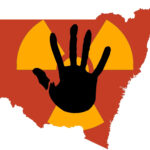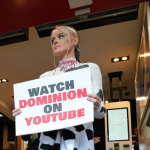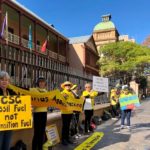Stop the Waste-to-Energy Incinerators, Demands Western Sydney Direct Action’s Melinda Wilson
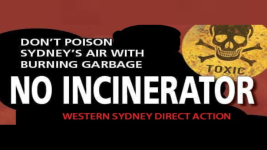
Right now, Next Generation and Cleanaway are proposing to build waste-to-energy incinerators in Western Sydney, despite a long-term public campaign against their establishment, which, last year, led the NSW Liberal Nationals government to rule them out.
Waste-to-energy (WTE) incineration involves the burning of community rubbish, with the resulting heat used to generate electricity.
However, despite our nation classing this as green technology, the burning of waste results in carbon emissions streaming out into the atmosphere.
Incinerating waste further sees carcinogenic pollutants released into the air, which include dioxins and nanoparticles of toxic heavy metals. This is of particular concern as the proposed Eastern Creek sites for both the incinerators are close by key Sydney water supplies.
Western Sydney Direct Action is campaigning for the Perrottet government to reject these proposals once again, as it points out that burning waste derived from fossil fuels is no different from burning the substances directly.
No new coal or gas
Last Sunday saw a coalition of over 30 civil society groups, including Western Sydney Direct Action, host an emergency rally at Sydney Town Hall, calling on the Albanese government to put an end to the approval of any new coal and gas projects.
Despite the new Labor government’s stated focus of dealing with the climate crisis, it’s got 114 new coal and gas projects in its sights. And this is coupled with plans to establish WTE incineration as a new source of so-called “green” energy.
Those participating in the No New Coal and Gas rally decried the federal government’s climate emissions reduction bill, which had just passed in the lower house, as its 43 percent reduction by 2030 target isn’t near enough to avert the growing climate crisis.
The protesters also called out the NSW Liberal Nationals government on its new anti-protest laws, which were rolled out in March with the aim of stamping out climate actions. These can see those participating in unapproved protests facing $22,000 fines and up to 2 years prison time.
No waste-to-energy incineration
Extreme weather events resulting from climate change are now a constant around the globe.
Indeed, the 2019-20 summer bushfire crisis brought this to a head locally, while this year has seen the onset of unprecedented floods along the nation’s eastern seaboard.
Western Sydney Direct Action further advises that while this nation has seen fit to label WTE renewable energy, in Europe, where it’s been employed for decades, there is no such green classification, and governments over there measure the carbon it emits.
Sydney Criminal Lawyers spoke to Western Sydney Direct Action spokesperson Melinda Wilson about the fact that incineration is next in line after coal in terms of harms, the impact that such technology would have on the west of the city, and the criminalisation of climate defenders.
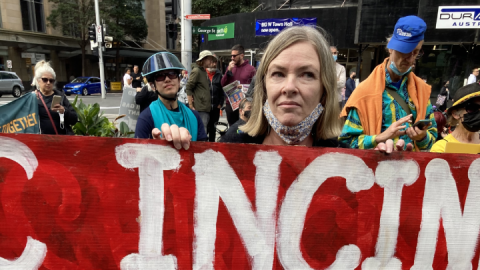
On Sunday, Western Sydney Direct Action joined a coalition of civil society groups in hosting an emergency climate rally in the Sydney CBD.
This demonstration came at the end of the first two weeks of parliament sitting under the Albanese government, which saw Labor’s greenhouse gas emission reduction bill pass through the lower house. This legislation has the target of a 43 percent cut by 2030.
Melinda, considering the new government has come to the table with climate targets that are much greater than the Coalition ever has, why was the rally still warranted?
If you add up all the coal, gas and WTE incinerators sitting in the planning system, you will see there is no way in hell this 43 percent reduction target could ever be met by then. It is just ridiculous.
At Sunday’s rally, your Anti-Incinerator Contingent was drawing attention to proposals by Next Generation and Cleanaway to establish waste-to-energy incinerators at Eastern Creek, out near Blacktown in Western Sydney.
In our country, WTE is classed as green technology and projects that use it are provided with renewable energy grants. However, your group points out that WTE has proven problematic in the UK.
Can you outline what WTE is, and why its classification as green energy is problematic?
Waste-to-energy is essentially a large incinerator, which will burn up to 500,000 tonnes per year of residual municipal solid waste and construction and demolition waste material, which includes asbestos, as well as commercial and industrial waste products that include plastics and metals.
The heat caused by this is used to generate electricity.
These incinerators would operate 24/7 for the next 30-plus years and employ 50 to 55 people on completion.
This project will cause a cumulative air pollution threat to the Sydney Basin. Burning plastics derived from fossil fuels does not create “green energy”, it is simply burning fossil fuels in another form. There is no way that it is green energy.
The Ferrybridge WTE incinerator in England is the reference facility for Next Generation. So, they’re saying that the incinerator here will be exactly the same. And reports show that Ferrybridge pumped out 942,913,980 kilograms of CO2 in 2020.
These incinerators are going to operate for at least 30 years, so can you imagine the amount of CO2 emissions that are going to be produced? This is not green energy. What the government is saying isn’t true.
When the government talks about phasing out fossil fuels and speeding up the switch to green energy, they could in reality be talking about waste-to-energy incineration instead of moving to true wind and solar renewable power.
In Australia, the CO2 emissions from incinerators are not measured or accounted for, as WTE incineration is classed as renewable energy and given grants from ARENA and CEFC. Yet, in England, CO2 emissions from incinerators are measured and reported.
There is no comfort in claims that predicted emissions will meet air quality protection standards when the federal government postponed action on our air quality protection standards, undermining the ability of state regulators to ensure smokestack industries, such as these projects, maintain the protection of air quality in the Blacktown area and Sydney Basin.
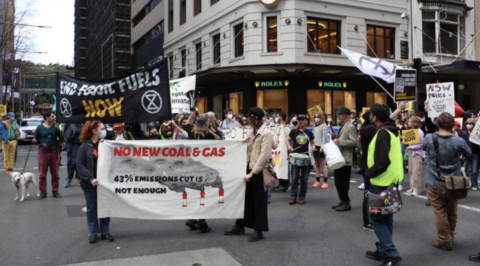
So, more broadly, what do these WTE proposals entail and what would be their impact?
The two incinerators will impact our drinking water, as they are near the reservoir that provides water to 5.1 million people in Greater Sydney. The two incinerators will be located within 5 kilometres of the reservoir.
Incinerators produce dioxins, and there are beef cows across the road from the incinerator sites.
The Hawkesbury-Nepean River is nearby, which has an industry on it. If any of those water sources are contaminated by dioxins, can you imagine what’s going to happen?
Once they get into your body, dioxins are there forever. They build up. They cause cancers. And when women have dioxins in their system, they go straight to the baby, into the growing foetus and via breastfeeding.
Our government states that the main objectives of the proposed developments are “to offer a viable alternative to the burning of fossil fuels by utilising a green and renewable energy source capable of servicing approximately 200,000 homes through the export of 137.3 MW energy”.
The government is lying to the Australian public about waste-to-energy as it’s not renewable energy when it produces so much CO2 per year.
Research has shown that operational incinerators overseas produce high amounts of CO2 emissions each year.
In Europe, where WTE incineration has been used for years, groups, such as Zero Waste Europe (ZWE), have called for an end to incineration, stating WTE is incompatible with climate change mitigation.
ZWE’s Janek Vähk says, “Once we phase out coal, incineration becomes the most polluting source of energy.
Each ton of incinerated waste raises the carbon impact of the EU’s energy system and, critically, undermines the EU’s 2050 net-zero emissions target.”
Europe and the States have never stopped incineration. We did have the sense to do so years ago. But now they have had the harebrained idea to bring it back again, under the name waste-to-energy to fool people into thinking it is renewable.
There are cancer clusters of residents who live upwind from incinerators overseas.
So, this technology was brought to a halt in Australia?
Yes. They shut down an incinerator in the city, around Botany. All they’ve done is rebranded incinerators as waste-to-energy.
So, people think it’s renewable, but in the end, it’s an incinerator burning waste.
And are these Western Sydney proposals the first such moves to bring back the technology since it was phased out?
Yes. The two in Western Sydney, and now there is one that’s been approved in Western Australia.
So, they’re saying we are getting out of coal. But they’re not going to green energy because waste-to-energy is the next step.
I went to an industry conference earlier this year, and they were talking about waste-to-energy and biomass energy, which means the burning of forests to generate electricity.
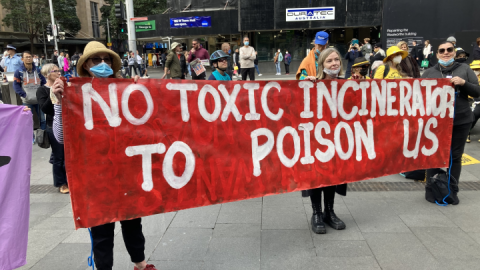
So, how does WTE come to be classed as green energy?
NSW had a waste-to-energy inquiry in 2017. Jane Bremmer, the secretary of the National Toxics Network, came over from Western Australia. She has been fighting against the one over there.
Bremmer asked the chair of this meeting whether WTE will be given renewable energy status? They then said no. But it has been.
Sunday’s action included members from Fireproof Australia and Blockade Australia.
The authorities have been cracking down on both these groups due to their nonviolent direct action.
The Perrottet government passed draconian protest laws in response to these demonstrations. And there have been stakeouts and raids on climate defenders since their rollout.
How do you consider the escalating criminalisation of climate protest?
It’s absolutely disgusting. They twist things around to make out that we are terrorists. Everyone knew that this was how these draconian laws would be used.
Most people who protest against these projects are doing it because they feel the government is not listening hard enough when it comes to the climate targets that we must meet.
These laws need to be seriously reconsidered. Protecting our climate, food growing areas and water doesn’t deserve the same gaol time as recklessly wounding a person or allowing your premises to be used for child prostitution. There is no comparison between these crimes.
These NSW anti-protest laws need to be challenged in the High court. They were originally based on the Tasmanian laws that were found to be constitutionally invalid.
This law can also be taken to high jurisdiction courts under article 61 of the Magna Carta, the founding document of our constitution, which states we have the right to enter into lawful rebellion if we feel we are being governed unjustly. This law is definitely unjust.
History has shown that the only way to get just laws is to enter into lawful rebellion. This is why we are rising for our climate and the future of our children and grandchildren because our government is not doing the right thing.
Tanya Plibersek said towards the end of last week that she’s considering knocking back Clive Palmer’s proposal to open a new coal mine in central Queensland, as it would harm the Great Barrier Reef.
This would mark the first time an Australian environment minister has refused a coal mine proposal. What are your thoughts on this development?
There is no way this coal mine should ever be approved. Common sense should tell the Australian government the same thing. This is why people have had enough.
Our government needs to act now, not set targets that don’t really mean anything.
And lastly, Melinda, the federal government is legislating climate action, but it’s not enough. Extreme weather events are now an ongoing occurrence around the globe, and the authorities are trying to silence those who are raising these issues.
So, how do you consider real climate action is going to eventuate? And how much time have we got to get there?
We won’t be silenced by their extreme anti-protest laws anymore. Actions speak louder than words.
Our government does not represent the people of Australia and what they want. When that happens the only way for real change is by standing up to make those changes happen.
We have seen it in history time and time again. It’s the only thing that forces real change.
Time is running out. We only have six years to turn this around or our children and grandchildren won’t have a future.
Does anyone really believe our extreme weather events are going to be better in the next 20 years? That’s the reality for future generations.
History has shown we can rapidly change things. Back in the 80s and 90s, they discovered that fluorocarbons were causing a hole in the ozone layer.
Today, the use of fluorocarbons is outlawed by 197 countries around the world and scientists agree that the ozone layer is slowly recovering as a result.
The success in addressing the ozone problem can give us hope that global environmental problems can and have been solved by working together.
Our government needs to act now, and a 43 percent reduction is just not enough. We must stop all fossil fuels and that includes CO2 emissions from waste-to-energy.



